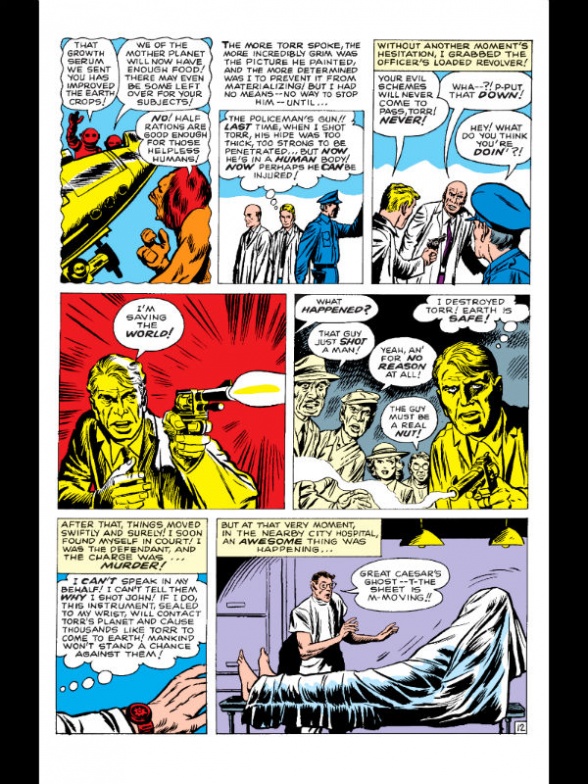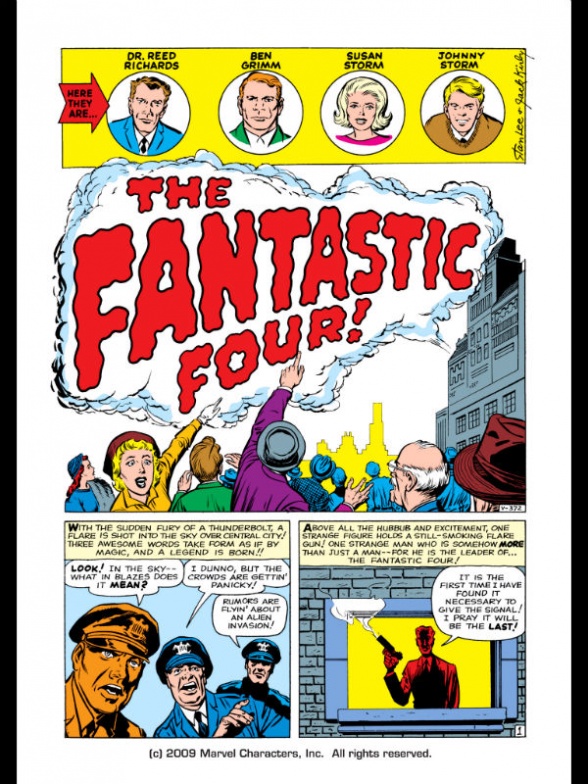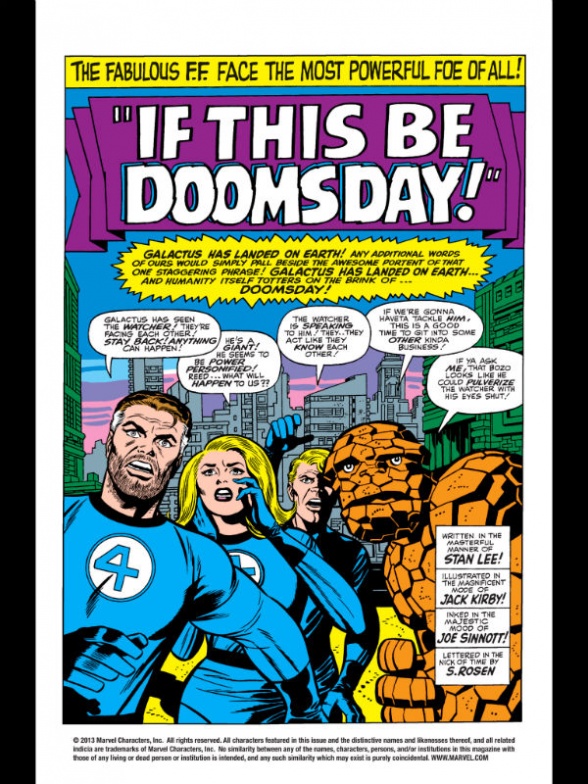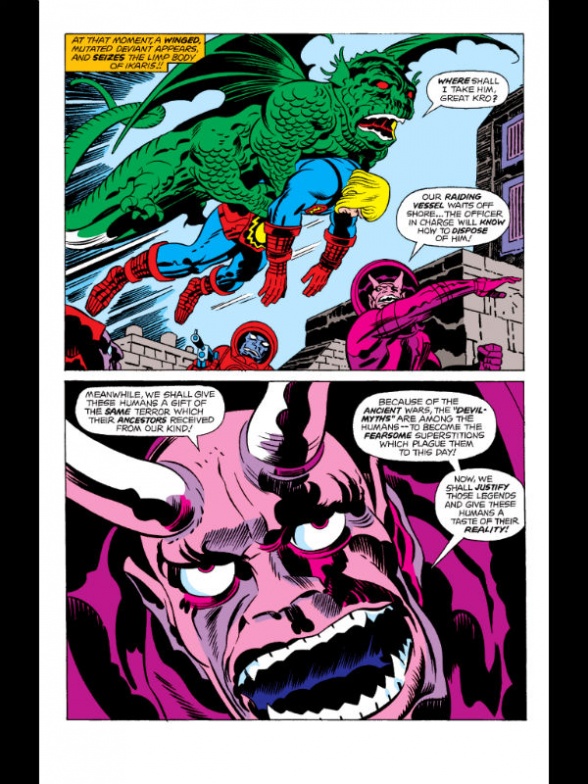100 years. That’s a hell of a lot of time to be around. So much can happen in 10 years, let alone 100 years. Companies rise and fall, trends change, stories grow, and what was once novel is now cliché. Artists and writers fall by the wayside and are buried underneath the tides of history. Yet, here we are, 100 years later, celebrating the work of Jack “The King” Kirby, and the massive legacy that he left behind.
To say that Jack Kirby is a comic legend would be an understatement. Not only is he responsible for co-creating many of the most iconic superheroes, Jack’s bibliography is absolutely packed to the brim with some of the weirdest stuff the Silver Age had to offer and, if you’ll indulge me for a bit, I want to do a quick recap of the journey he took throughout his career before settling into a deeper look at his stable of Marvel comics.
Picture this. You’re young and looking for a job in New York telling stories. You find yourself as an in-betweener for the Popeye cartoons and then working with Will Eisner, among others, creating newspaper strips. You then end up finding a great creative partner, Joe Simon, and the two of you work together at this company called Timely Comics where you produce a little known comic called “Captain America.”
Soon, though, you’re unsatisfied with your pay at Timely and the two of you hightail it over to their competitor, National Comics (also known as DC comics). And thus begins the first of many times that you’d jump between these two companies, though with each jump, the names and your collaborators would change. By the end, it’s just you, creating sprawling space epics that get canceled way too soon (we’ll get to that later).

'Captain America Comics' #1
Quite a life you just lived, isn’t it? And that’s not even getting into the work for other companies and industries Kirby worked for or the legacy he spawned. As much as I would love to do a full on biography, that is not the purpose of this article. What I wanted to do instead was to give a relatively brief look (only 2000 or so words) at Kirby’s art at Marvel comics when it was called Marvel (sorry Timely and Atlas comics), with special mention for his iconic Captain America punching Hitler cover from “Captain America Comics” #1. Because you can never have enough of Cap punching Nazis.
Also, while I’ll be spending my time delving into some of Kirby’s hundreds of issues at Marvel (100+ of which are just “Fantastic Four”), Kevin will be diving into the DC depths in the other half of this retrospective.
Alrighty! Then without any more pomp and circumstance, Sherman, set the Wayback machine to New York City, early 1960s! Don’t worry, I won’t make any bad puns at the end of this, I promise.
Pre-superhero Marvel

'Amazing Adventures' #5
It might seem odd to consider but Kirby’s early work at Marvel proper wasn’t in the superhero comics. This was due mainly to the fact that, post-comics code, superheroes really struggled to find a place on the shelves. Marvel’s big books at the time were titles like “Strange Tales” or “Journey into Mystery,” anthologies of sci-fi/fantasy (code appropriate of course). As such, this is where Kirby was able to really cut his teeth on some of the gripping, grand epics that he perfects later on in his career, right?
Well, not so much. As much as I would love to say Kirby was the king from the get go, the actual quality of his early work (art wise) suffers from being trapped by the style of story he was forced to tell, that of the giant monster/alien. Many of the stories he writes are single issue adventures, featuring a different monster and a different cast of white dudes. It was also the Silver Age, so the pacing is fast, completing the story in 17 or fewer pages, with simple paneling and tons of overly descriptive dialogue, which can make Kirby’s work here feel, to a modern audience, deeply flawed.
Continued belowHowever, there is a reason why Kirby is considered the king, and we can see the beginnings of it in these early monster works. For one, it’s where he got to really flex those creature design muscles, some of which are still kicking around the Marvel universe now (before the “Monsters Unleashed” event). Fin Fang Foom, the Hulk villain, got his start as a short story in “Strange Tales #89” and everyone’s favorite dancing tree, Groot, got his, albeit very different, debut in “Tales to Astonish” #13.

'Amazing Adventures' #1
It is certainly apparent, though, that these are some of his earlier works and before he really developed the style that comes to prominence during his ‘Fourth World’ saga. The humans in his stories rarely have consistent faces, with mouths regularly having disappearing teeth or lopsided faces, their bodies contorting into spaghetti poses. His monsters, on the other hand, are very distinctive, even if many of their motivations (and covers) are similar. Just compare “Amazing Adventures” #1 and #5’s covers.
Both feature the monster towering over a group of humans, feature an arrow pointing at and describing our newest melty-looking monstrosity, and are totally not indicative of what’s actually in the leading story or the in-magazine design. In fact, the first page of the comics are similar enough to the cover that it feels like we’ve entered the action…in a slightly different, parallel universe. What’s that saying about books and their covers again?

'Amazing Adventures' #1
Someone accidentally let their inner Superman fan leak out.
While Kirby’s early Marvel work may be best described as creative but repetitive but exactly what was expected of the magazines he ran in, it was with the rebirth of the superhero genre that he found his groove once again. Teaming up with the man himself, Stan Lee, with whom Kirby had a, let’s go with, rocky work relationship, Kirby proceeded to create so many of the iconic marvel characters that now grace the shelves and the big screens every few months.
To start we’ve got our favorite exception to this article, Captain America (from Timely comics), Black Panther, Sgt. Fury (pre-eyepatch), Silver Surfer, Hulk, Iron Man (in conjunction with Larry Lieber and Don Heck), Nick Fury (post-eyepatch), Ant-man, Galactus, teams like the Howling Commandoes, The Avengers, The Inhumans, X-men, and a little known book called “Fantastic Four” in addition to a plethora of villains, minor characters and organizations (such as S.H.I.E.L.D. AND HYDRA).
This is the era where Kirby begins to find his style and where we can see him learn from his previous monster books. Probably the best example of that is “The Incredible Hulk” #1 from May 1962. Not the first of the new Marvel superheroes, that honor goes to “Fantastic Four” #1 from November 1961, who I’ll get to in just a moment.

'The Incredible Hulk' #1
In Hulk’s book, we see the traditional monster format that graced the pages of “Strange Tales” or “Amazing Adventures” play out once again. We have the hulking monster tower over all the humans on the cover and, were I not to have known what was going on, it could easily be read as Bruce (or, to the ignorant version of me, random scientist) on the cover is being mind controlled by this grey beast. Kirby’s covers are always very dynamic and this is no exception. With the rocket going off in the back, the humans striking distinctive and energetic poses as well as those beautiful action lines and the plethora of text enticing us to open up the issue to answer the question, “Is he a MAN or MONSTER or…Is he BOTH?”
When you open the issue, the first page is, once again, a slightly varied version of the cover monster, prominently displayed in a splash page that heralds the first of a two part story. However, this is where the differences begin to show. Instead of being two-fifths of a whole issue, the Hulk story encompasses all five parts. Additionally, the monster is our main character and, while not being the nicest, still garners enough of our sympathy to care about him. Kirby’s people are also beginning to take on more of his signature, boxy-faced look.
Continued below

'Incredible Hulk' #1
Still, as with every artist, this was a time of growth for Kirby beyond just his artistic consistency. As I said earlier, this was the period where he begins to really develop his own style of character design. Take the Fantastic Four in their first appearance and compare it to their appearance in “The Avengers” #1, and then again to their appearance in “Fantastic Four” #48-50.

'Fantastic Four' #1
In their first appearance, the first family looked more akin to Kirby’s older, monster of the week, character. Reed’s owl like face and wavy ruffled hair is a far cry from his later, more filled out, square face and smooth, shiny hair. The Thing, while not displayed as The Thing on the page above, is depicted more as a melty mud-like creature, more akin to Clayface than a rock monster. He’s drawn, much like the Hulk was, in the style of his older monsters, thick, lumbering, and looking like he could melt at any moment.
The Human Torch is drawn as a series of flames all attached to each other and, while Susan’s design remains mostly the same (save for the hair style in “The Avengers”), you can see the level of detail in her eyes and face grow more and more as the years progress, making her able to convey a much wider variety of emotions.

'The Avengers' #1
By the time we’ve gotten to “The Avengers” #1, that filling out of Reed has occurred and, although his features (especially his thick eyebrows) still give off that owlish vibe, he has a more defined face than before and it is now a recognizable icon as opposed to just being another generic protagonist. The Human Torch is now more human than torch, no longer entirely flames but a red man covered in inking lines, dragging the flames around like a bridal train. The Thing, unfortunately, doesn’t make an appearance here and Susan, as I stated before, just gains a cool? new hairdo.
And then comes issues #48-50 of their solo series. I chose to look at these because this is the comic that introduces Galactus, Devourer of Worlds and I would be remiss if I didn’t talk about or at least show a bit of his introduction. At this point we’re halfway through Kirby’s run on “Fantastic Four” and the quality of the art is so drastically different than the previous two issues we looked at. Kirby has had a few more years to refine his skills and now having worked with the same characters for that long instead of having to create new, blank slate characters for each new, short, self-contained story, he has been able to expand creatively and experimentally.

'Fantastic Four' #49
Firstly, the Fantastic Four have faces that feel real now. I’ve been dancing around it but for a while, those early faces always have something that is a bit off. Be it the eyes are too wide apart or the facial features are too far down on the face itself. By now, though, even in the mid-shots Kirby is able to keep his characters looking consistent and still distinct. The Thing continually looks rocky and moves in exaggerated but realistic ways.

'Fantastic Four'#49
I do have some gripes with The Human Torch’s design, I prefer his original but I understand why it changed. Drawing those flames much have been time consuming and you lose a lot of physicality and facial expressions.
Second off, the appearance of Galactus has allowed Kirby to break out some truly wonderful background work. Empty seas littered with dead ocean life, massive alien machinery covered in circuitry, planets of strange shapes and colors, and a sky filled with that signature Kirby crackle. This is an arc that, even if you aren’t a fan of the Silver Age, is worth reading.
Continued belowHe captures the grand scale that a catastrophe like Galactus would cause as well as having dynamic action scenes that are clear and feel weighty. The overly dramatic watcher, heavily covered in shadows in issue #50 is both hilariously silly now but fits within the story, adding an another layer of gravitas to the comic. Then, once the crisis is averted, the family drama continues, until, 50ish issues later, Kirby leaves the title and the company. But only for a little while.
All in all, during the decade that Kirby worked for Marvel before he left for DC again, he had fully worked on around 450 comics and provided layouts for 46 additional comics. That’s a lot of comics. Yet that allowed him to grow and to lay the groundwork for what was to come over at DC.
The Return and the Sci-Fi
And yet, despite leaving Marvel under less than ideal circumstances, in 1975 he returned to the company, ready to work again on those comics that left such a lasting impact on the Marvel readership…Sci-fi Epics!
Yep. Once Kirby returned to the house that he helped build, it wasn’t to write and illustrate any more superhero work (although he did do some of that). No, instead he returned to do new versions of the work that he had previously been doing at DC.

'Black Panther'#1
He only worked on five titles during his final years at Marvel: “The Eternals”, “2001: A Space Odyssey”, “Devil Dinosaur”, “Captain America”, and “Black Panther”. Additionally, unlike his previous time working for Marvel, all the titles he worked on were written by himself as well, which might explain the large leaning towards the cosmic sci-fi, monster mashes that started his career at Marvel.
“Black Panther” #1’s cover has it all. Crazy costumes? Check. Giant eyes, large noses, wide but angular faces? Check. The Kirby crackle on a time-traveling frog that also seems to be split in half? Che- Wait.
Ah, Kirby. Your imagination never fails. But what I want to focus on in this small portion of his career is his second attempt to create a large space opera, “The Eternals.”
“The Eternals,” while never having an official end by Kirby himself, sets up the daunting task of creating a sprawling epic battle between the three races of creatures on Earth that were created by an alien race called The Celestials: the Eternals, the Humans, and the Deviants. While the names are simple, the comic is not.

'The Eternals' #2
It has the feel of a sprawling epic, with heavy shadows and massive, tech covered, alien beings. It even has a good old fashioned devil laying waste to cities in fire and brimstone. Kirby, by this point, has perfected his style, for better or for worse. Because of the way he draws faces, while they tend to look distinct, they can sometimes be exceptionally wide and can lead to some unintentionally hilarious crowd shots as well as giving us shots of Ikaris, of house chiseled chin, looking exceptionally polygonal.
His monsters, however, benefit from this style. It gives them that otherworldly feel, especially with their deep yellow eyes and curved, fanged mouths. There are just so many great pages from this one series such as when Kro, the Deviant who used his atomic manipulation powers to grow horns and look like the devil, has just captured Ikaris and is giving his evil speech to the sky. He looks deliciously evil and Kirby takes half a page to just show his face, heavily inked and bathed in purple.
This is where Kirby shone. In the grand, in the crazy, in the monstrous.

'The Eternals' #3
And then it was over. Kirby was at Marvel for only a few years post-New Gods and then he left, off to different projects until his death in 1994. So, what remains of his work? How is he remembered within the Marvel Universe?
I think a better question would be, how isn’t he? Save for Spider-man, Kirby was responsible for co-creating all of Marvel’s biggest heroes as well as bringing a unique look to the cosmic potentials. If I were to try to list everything that was inspired by Kirby or directly descended from his work, this article would be 10x as long as it is already. But allow me to indulge a bit with a where are they now.
Continued belowKirby’s monsters had their own even recently and are now leading a series. Fin Fang Foom, everyone’s favorite alien dragon, was in that event and has been fairly active in the Hulk books. Even Monsteroso from “Amazing Adventures” #5 made a reappearance in the pages of “Black Bolt.” The X-Men and Fantastic Four, while having been placed on the back burner for a bit, are still as popular as ever and the X-men at least, are making a return to prominence.
Years after it was canceled, “The Eternals” had its story concluded in the pages of “Thor” and retold by Neil “I love me some sprawling cosmic fantasy” Gaiman in his 7-issue mini-series “Eternals.” Black Panther is going strong under the guidance of Ta-Nehisi Coates and the Avengers are, well, the Avengers. Galactus, on the other hand, has been enjoying a nice planet filled with nuts in a lovely robe. I’d say that’s a step up from battling the “Fantastic Four.”
Looking back at Kirby’s career at Marvel is a tough one. As you saw if you’ve made it this far, he’s drawn a lot of comics and a lot of stories. His stories, even if they may show their age, are still enjoyable and epic to this day. Kirby was a master of action, of drama and of scale. He knew how to make something imposing seem grand and when to make it seem terrifying. He could make a lumbering rock monster a force to be reckoned with or he could give it a heart of gold. Nuance may not have been his specialty but when you’re the king, you can afford to be a little unsubtle.
All biographic information is from the Kirby Museum Website. If you want to see uncolored art from many of Kirby’s comics, including his bonkers “2001: A Space Odyssey” adaptation, check out Whatifkirby.com. It’s a really cool site.



